
Orange is a town in New Haven County, Connecticut, United States. The population was 14,280 at the 2020 census. The town is governed by a Board of Selectmen.

The Hancock–Clarke House is a historic house in Lexington, Massachusetts, that is a National Historic Landmark. Built in 1738, the house is notable as the only surviving house associated with statesman John Hancock, who lived here for several years as a child. It played a prominent role in the Battle of Lexington and Concord as both Hancock and Samuel Adams, leaders of the colonials, were staying in the house before the battle. The House is operated as a museum by the Lexington Historical Society. It is open weekends starting in mid-April and daily from May 30–October 31. An admission fee is charged.

The Captain Elisha Phelps House is a historic house museum at 800 Hopmeadow Street in Simsbury, Connecticut. The colonial-era house was built by David Phelps in 1711. His son Elisha Phelps received the land from his father and expanded the house in 1771. Elisha Phelps along with his brother Noah Phelps and others took part in the capture of Fort Ticonderoga in 1775. Capt. Phelps was appointed as commissary of the Northern Department by the Continental Congress.
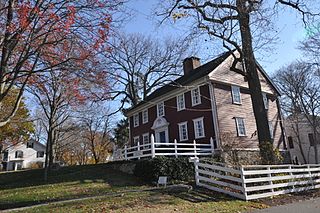
The Captain David Judson House is a historic house at 967 Academy Hill in Stratford, Connecticut. It was built by David Judson ca. 1750. The new house was built on the stone foundation and incorporates the chimney of the original house built on the site in 1638 by Judson's great grandfather William. William left the house to his son Joseph Judson in November 1660 when he removed to New Haven. Nine generations of Judsons lived in the house until 1888.

The Northside Village Historic District encompasses a rural village center on Stafford Road in northern Charlton, Massachusetts. Located at the junction of Stafford Road with Northside and Cemetery Roads is a small cluster of residential buildings, developed beginning in 1735 around a small tanning business, and later as a stagecoach stop. The district was listed on the National Register of Historic Places in 1977.

The Fairfield Historic District encompasses the historic town center of Fairfield, Connecticut, roughly along Old Post Road between U.S. Route 1 and Turney Road. The area contains Fairfield's town hall, public library, and houses dating from the late 18th century, and includes portions of the town's earliest colonial settlement area. The district was listed on the National Register of Historic Places in 1971.

The Jonathan Wheeler House is a historic house on North Society Road in Canterbury, Connecticut. Built c. 1760, it has features unusual for its time, including end chimneys and a center-hall plan. The use of brick in this part of rural Connecticut is also unusual for the period. The house was listed on the National Register of Historic Places in 1982.

The Nathaniel Backus House is a two-story Greek Revival clapboarded house with a gable roof in Norwich, Connecticut. The house was built around 1750 by Nathaniel Backus and served as his home, it was later moved to its current location in 1952. The house originally began as a Colonial, but was greatly modified to Greek Revival around 1825, reconfiguring the central door to the left of the facade and adding two chimneys. The house is a historic house museum operated by the Faith Trumbull Chapter of the Daughters of the American Revolution.

The David Lambert House is a historic house museum at 150 Danbury Road in Wilton, Connecticut. Built about 1726 by one of the town's early settlers, it is a well-preserved colonial-era house with later Federal and Colonial Revival alterations. It is now owned by the local historical society. It was listed on the National Register of Historic Places in 1992.
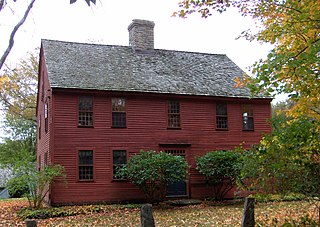
The Oliver White Tavern is a historic former tavern at 2 Brandy Street in Bolton, Connecticut. Built approximately 1750 as a residence, it is a good example of Georgian architecture. The tavern is historically significant because of its association with the march of Rochambeau's army during the American Revolutionary War, on their way to the Battle of Yorktown. The building, now a private residence, was listed on the National Register of Historic Places in 2002.

The John Cady House, also known historically as the Babcock Tavern, is a historic house at 484 Mile Hill Road in Tolland, Connecticut. With a distinctive construction history dating to 1753, it serves as an important window into the construction methods and techniques of the 18th and 19th centuries. It was listed on the National Register of Historic Places in 1982.
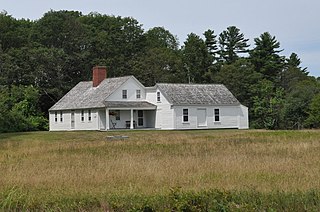
The Tarr–Eaton House, also known as Tarr–Eaton–Hackett House, is an historic house at 906 Harpswell Neck Road in Harpswell, Maine. Built before 1783 and enlarged about 1840, it is a well-preserved 18th-century Cape with added Greek Revival features, and one of Harpswell's few surviving pre-Revolutionary War buildings. It was listed on the National Register of Historic Places in 2001.

The William Tully House, also known as Hartsease or Heartsease, is a historic house at 135 North Cove Road in Old Saybrook, Connecticut. Built about 1750, it is a well-preserved and architecturally unusual example of period architecture. It also has a well-documented history, having association with one of Connecticut's leading physicians of the early 19th century, and an incident in the American Revolutionary War. It was listed on the National Register of Historic Places in 1982.

The Marlborough Tavern, also known historically as the Col. Elisha Buell House, is a historic house and former tavern at 3 East Hampton Road in Marlborough, Connecticut. Built in 1760, it was for many years a prominent stagecoach stop, and a center of the town's civic activities. It was listed on the National Register of Historic Places in 1978.

West Street School is a historic one-room school house at 1432 West Street in Southington, Connecticut. Built about 1760, it is the oldest surviving school building in the town. It served the town as a school until 1946, and is now preserved by the Southington Historical Society. It was added to the National Register of Historic Places in 1988.

The Kent Neighborhood Historic District encompasses a little-altered early 19th-century rural neighborhood of Dorset, Vermont. Centered at the junction of Dorset West Road and Nichols Hill Road, the area is also historically significant as the site in 1775 of the first meetings that culminated in Vermont's period of independence prior to become the 14th United States state. The district was listed on the National Register of Historic Places in 1978.

The Marvin Newton House is a historic house museum on Ridge Road in the Brookfield Center village of Brookfield, Vermont. Built about 1835, it is a fine example of vernacular late Federal period architecture. It was given to the local historical society by descendants of Marvin Newton, the likely builder, in 1937, and has been a museum property since them. It is open on limited weekends during summer months. It was listed on the National Register of Historic Places in 1980.
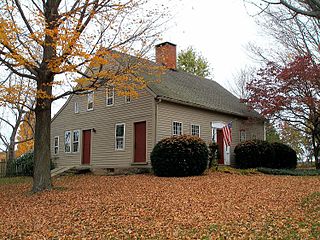
The Roderick Bryan House is a historic house at 867 Linkfield Road in Watertown, Connecticut. Built about 1820, it is a well-preserved example of a rural Cape style farmhouse. It was listed on the National Register of Historic Places in 2000.

The Salmon Brook Historical Society is the local historical society of Granby, Connecticut. The society's museum property is located and 208 Salmon Brook Street, and includes four historic buildings, which include museum displays of historic items, and a small research library. Two of the buildings, the Rowe and Weed Houses, are listed as a pair on the National Register of Historic Places.
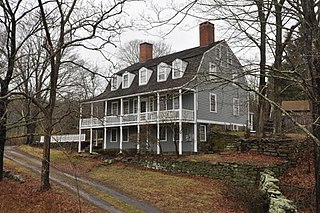
The Medad Stone Tavern is a historic house museum at 191 Three Mile Course in Guilford, Connecticut. Built in 1803 but never actually used as a tavern, it is well-preserved example of early 19th-century Federal period architecture. It is now maintained as a museum by a local historical society. It was listed on the National Register of Historic Places in 2009.






















